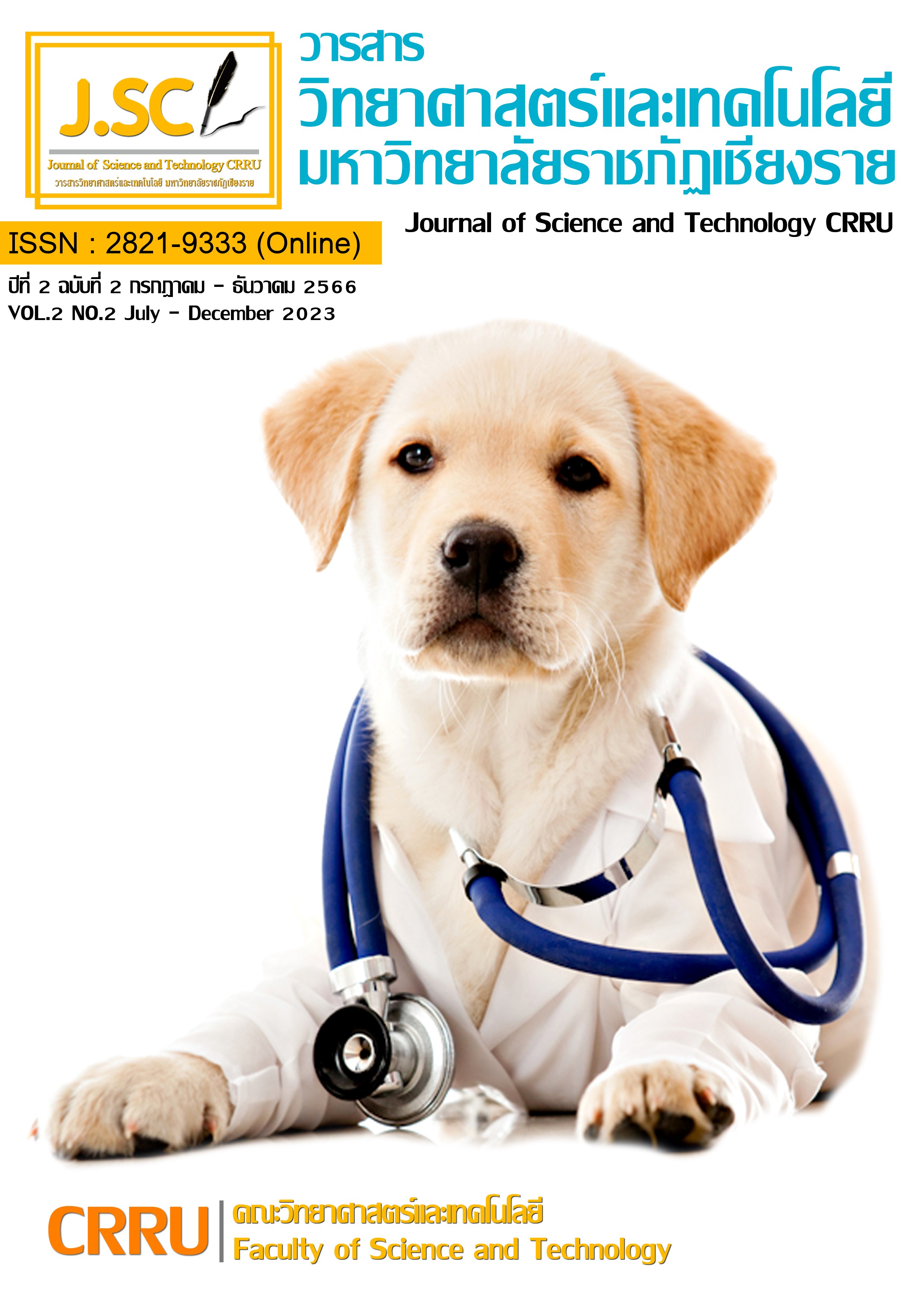Antioxidant Activity of Cocoa Bean Shells for the Development of Cocoa-Based Tea Products
Main Article Content
Abstract
This study aimed to evaluate the potential value addition of cocoa bean shells (Theobroma cacao L.) in the production of tea to promote healthy consumption. The study involved examining the amount of antioxidants in cocoa bean shells tea in comparison to cocoa beans tea. Various tea brewing methods were investigated, including boiling tea bags and steeping tea bags in hot water. Additionally, tea was extracted using a 60% ethanol solvent with the assistance of an ultrasonic machine. The results showed that cocoa beans and cocoa bean shells extract had a total phenolic content of 226.09 and 221.78 mg gallic acid equivalent (GAE)/g of dry tea, while the total flavonoid content was measured at 172.00 and 126.10 mg equivalent to quercetin/g of dry tea, and antioxidant activity was determined to be 85.77% and 86.16%, respectively. Cocoa bean shells exhibit high antioxidant activity similar to cocoa beans, with the amount being 5-10% of the extraction method. Furthermore, when preparing cocoa bean shell tea by boiling tea bags and steeping tea bags in hot water, the total phenolic content was measured at 16.27 and 22.40 mg gallic acid equivalent (GAE)/g of dry tea, the total flavonoid content at 8.01 and 4.47 mg equivalent to quercetin/g of dry tea, and the antioxidant activity at 85.76% and 75.02%, respectively, for boiling and steeping tea bags in hot water. These findings highlight the potential of utilizing cocoa bean shells for tea production, thereby enhancing the value of this discarded waste material.
Article Details

This work is licensed under a Creative Commons Attribution-NonCommercial-NoDerivatives 4.0 International License.
Journal of TCI is licensed under a Creative Commons Attribution-NonCommercial-NoDerivatives 4.0 International (CC BY-NC-ND 4.0)
References
ศิริพร เหลียงกอบกิจ. (2551). โกโก้ที่มาของความอร่อย. จุลสารข้อมูลสมุนไพร, 25(4), 3-12.
Poveda, O.R., Pereira, L. B., Zeppa, G., & Stévigny, C. (2020). Cocoa Bean Shell-A byproduct with nutritional properties and biofunctional potential. Nutrients, 12(4), 11-23.
Bakkalbasi, E., Mentes, O., & Artik, N. (2009). Food ellagitannins-occurrence, effects of processing and storage. Critical Reviews in Food Science and Nutrition, 49(3), 283-98.
Fantini, M., Benvenuto, M., Masuelli, L., Frajese, G.V., Tresoldi, I., & Modesti, A. (2015). In vitro and in vivo antitumoral effects of combinations of polyphenols, or polyphenols and anticancer drugs: perspectives on cancer treatment. International Journal of Molecular Sciences, 16(5), 9236-82.
Hammerstone, J. F., Lazarus, S. A., Schmitz, H. H., & Schmitz, H. R. (2000). Procyanidin content and variation in some commonly consumed foods. Journal of Nutrition, 130(8S Suppl), 2086S-2092S.
Joomwong, A., & Katdee, W. (2020). Effects of brewing time period on Physical and Chemical Quality, Antioxidant activity and Sensory quality of Gynostemma pentaphyllum Tea. Agriculture and Technology Journal, 1(1), 27-37.
Inchuen, S., Pornchaloempong, P., & Narkrugsa, W. (2010). Effect of drying methods on chemical composition, color and antioxidant properties of Thai red curry powder. Kasetsart Journal - Natural Science, 44, 142- 151.
Hu, Z., Tang, X., Liu, J., Zhu, Z., & Shao, S. (2016). Effect of parboiling on phytochemical content, antioxidant activity and physicochemical properties of germinated red rice. Journal of Food, 214, 285-292.
Namchot, C., Phasuk, S., & Takonphakdee. P. (2013). Efficiency of Feronia lomonia swingle branch crude extract as antioxidant. pp. 251-260. In the 5th Rajamangala University of Technology National Conference, 28 March 2014, IMPACT Muang Thong Thani, Nonthaburi.
Sánchez, M., Laca, A., Laca, A., & Díaz, M. (2023). Cocoa Bean Shell: A By-Product with High Potential for Nutritional and Biotechnological Applications. Antioxidants, 12(5), 10-28.
Gumelar, Firmanto, H., & Nurcholis, M. (2022). Antioxidant Content of Tisane of Cocoa Bean Shells as Affected by Roasting Temperatures. Pelita Perkebunan, 38(3), 200-210.
Garc´ıa-Alamilla, P., Lagunes-Gálvez, L.M., Barajas-Fernández, J., & García-Alamilla, R. (2017). Physicochemical changes of cocoa beans during roasting process. Journal of Food Quality, 2017(1), 1-11.
Gumelar, Firmanto, H., & Nurcholis, M. (2022). Antioxidant Content of Tisane of Cocoa Bean Shells as Affected by Roasting Temperatures. Pelita Perkebunan (a Coffee and Cocoa Research Journal), 38(3), 200-210.
Irondi, E.A., Adegoke, B.M., Effion, E.S., Oyewo, S.O., Alamu, E.O., & Boligon, A.A. (2019). Enzymes inhibitory property, antioxidant activity and phenolics profile of raw and roasted red sorghum grains in vitro. Food Science and Human Wellness, 8(2), 142–148.
Lopes, S.M.D.A., Martins, M.V., Souza, V.B. de, & Tulini, F.L. (2021). Evaluation of the nutritional composition of cocoa bean shell waste (Theobroma cacao) and application in the production of a phenolic-rich iced tea. Journal of Culinary Science & Technology, 21(5), 818–828.


